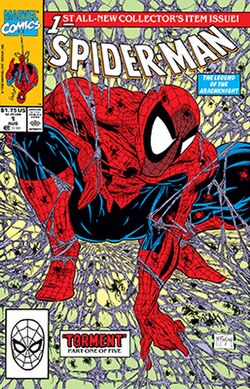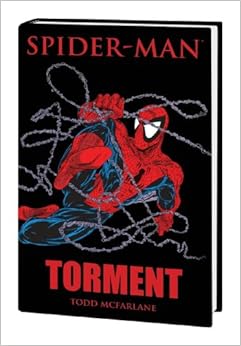"Torment" is a story arc written by Todd McFarlane, which encompassed the first five issues of the new ongoing Spider-Man comic book. It was published in 1990 by Marvel Comics. The comic was a record-breaking sales success and helped start the next stage of development in the Modern Age of Comic Books, which would lead to the formation of Image Comics and the rise of the speculator market.
Plot synopsis

The Lizard is going on a murdering spree before Spider-Man tries to stop him. The Lizard poisons Spider-Man and throws him off of a building. It is later revealed that Calypso is hypnotizing The Lizard to do her bidding. Spider-Man defeats both Calypso and The Lizard, but Spider-Man believes The Lizard dies from Calypso's effect on his brain.
Publication history

McFarlane had been the artist for The Amazing Spider-Man for a long time, and it was for Spider-Man #1 that McFarlane moved to be the artist and the writer:
Editor Jim Salicrup has said it came about organically, leading on from McFarlane's dissatisfaction with the inkers, which led to him taking over the writing too:
Part of the thinking was to make more trade paperback-friendly stories:
They were also inspired by Epic to try better paper quality. Marvel would not introduce it into a current series because of the increase in price, but if they started a new title they could go ahead with their plans.
Reception

The first issue would sell 2.65 million copies, setting a record at the time. The following year, Rob Liefeld's X-Force #1 (August 1991) went on to sell 3.9 million, then a couple of months later Jim Lee's X-Men #1 (October 1991) sold 7.5 million copies, these sales being driven by heavy use of collector cards and variant covers. Within a year these superstar artists would leave Marvel to form Image Comics off the back of the success on these titles and developments started in these comics would lead to the speculator boom of the mid-1990s.
However, according to Dave Wallace at Comics Bulletin, "commercial success didn't equate to critical acclaim for McFarlane's new venture, and many found the artist's attempts at writing to be clumsy, unsophisticated and pretentious" and that "[t]here was a frequent sense - as with many writer-artists - that McFarlane's scripts were being written in such a way as to give himself something "cool" to draw, rather than to provide a particularly compelling or satisfying story." The writing was also picked up by Alex Rodrik at Comics Bulletin who highlights the lack of consistency in the narration (switching from first person to third-person), concluding that "Torment is nothing more than a showcase of Spider-Man's fluid movement, and while the art is wonderful, it should be noted that pages (at times) are congested and indulgent." Even for fans of the series at the time the series has not stood the test of time. Augie De Blieck Jr. confesses that "[w]hen they first came out, I was a mind-numbed McFarlane fan" but reading the trade paperback he found that "the money shots of Spidey over the city and fighting for his life still look as energetic and lively as ever, the rest of the pages feel claustrophobic" and that Parker's lettering was "awful."
Even McFarlane admits his first run at writing a series has problems:
Collected editions

The series was first collected as a trade paperback in 1992 and has been reprinted a number of times since:
- Spider-Man: Torment (128 pages, softcover, Marvel Comics, June 1997, ISBN 0-87135-805-0, Boxtree, 96 pages, December 1997, ISBN 0-7522-0385-1, hardcover, Marvel Premiere Classic #27, 144 pages, July 2009, ISBN 0-7851-3791-2)
Notes

References

External links

- Spider-Man: Torment at the Marvel Database Project
- Retro Review: Todd McFarlane's 'Torment' at Pink Kryptonite
- Spider-Man: Torment at Rambles: a cultural arts magazine

